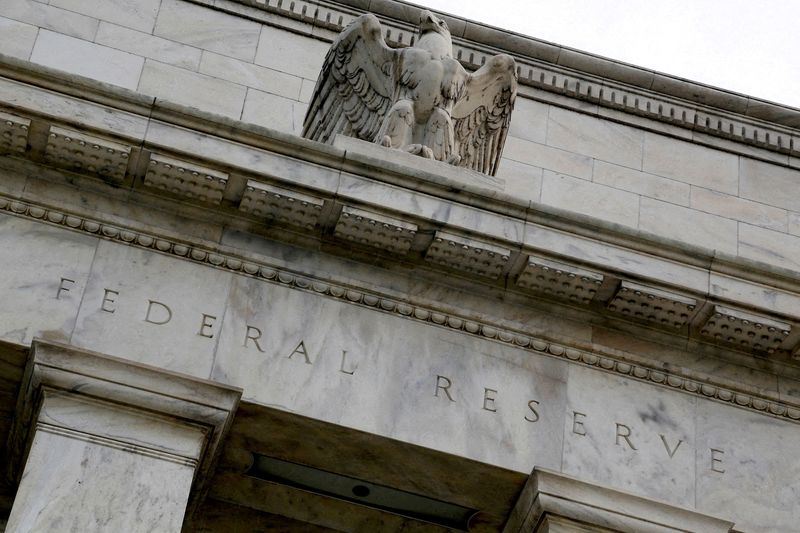By Howard Schneider, Balazs Koranyi and William Schomberg
WASHINGTON/FRANKFURT/LONDON (Reuters) - Global central banks that raced to raise interest rates last year amid soaring inflation are now laying the groundwork in unison for a pause that, while not yet promised, is coming into view for later this year.
The shift was couched in different ways when top central bankers issued their latest policy statements this week, and is likely to play out at different speeds among a group of nations where war, trade, energy and other factors have influenced prices to varying degrees.
All said they remain committed to keeping credit conditions as tight as necessary to return inflation to their common 2% target from current levels still far above that.
But the language also marked a clear turn from the discussion of one-sided inflation risks that dominated central bank discourse last year, touching off a global stock market rally, a decline in German and U.S. government bond yields, and sparking bets among investors that the end of rate hikes will now come sooner than later.
In both the United States and Europe, the words of central bankers led investors to cut their estimates of the peak or "terminal" rate expected in the current tightening cycle.
That may be premature, IMF financial counselor Tobias Adrian warned in a blog post.
With financial conditions loosening despite rising policy rates, "central banks must...be resolute in their fight against inflation and ensure policy remains appropriately tight long enough to durably bring inflation back to target," Adrian and others wrote.
Still, the shift in tone seemed notable.
Bank of England officials dropped a promise of further "forceful" rate increases, if needed, following the latest half-point increase, with Governor Andrew Bailey saying the BoE had "seen the first signs that inflation has turned the corner."
Fed Chair Jerome Powell on Wednesday referred repeatedly to a "disinflationary" process that was taking hold in the U.S. economy and allowed the Fed to raise rates by just a quarter of a percentage at its latest meeting - the smallest step since it began raising the target federal funds rate in March.
Rates still needed to rise, Powell said, but if the economy and inflation evolve as officials expect the U.S. central bank may only need a "couple" more quarter point increases to reach a level needed for inflation to continue falling.
The European Central Bank seems furthest from a likely stopping point.
"The Governing Council will stay the course," European Central Bank President Christine Lagarde said after the ECB raised its key policy rates by half a percentage point and said it intended a further half-point increase at its next meeting in March.
"What about after March? Does that mean you have reached the peak? No. We know we have ground to cover," Lagarde said.
START OF THE ENDGAME
But tucked in that guidance was a promise also to evaluate in March what further steps might be needed in an environment where inflation risks, Lagarde said, had become "more balanced."
“The tone...was far less hawkish than expected. President Lagarde guided for another 50bps hike in March, but did not provide clear guidance for monetary policy after then," said Gabriele Foà, co-portfolio manager at Algebris Investments.
The Bank of Canada last week became the first of the larger central banks to fully take the plunge, with Governor Tiff Macklem announcing that the country was "turning the corner on inflation" and that its latest quarter point increase would be followed by a "conditional pause."
Combined, the statements mark the start of the endgame for central banks that were slow to recognize the onset of inflation last year before engaging in a record-setting round of rate increases.
It also comes alongside data showing the world's major economies proving more resilient in the face of high interest rates than had been expected, with recession risks either receding or, in the cause of Europe, the depth of an anticipated downturn diminishing.
Central bankers long ago stopped using the word "transitory" in reference to inflation that proved faster and more persistent than any expected.
But what has begun to play out has aspects of the narrative policymakers initially hoped would transpire, with prices easing in part because business and households returned to more normal patterns of production and consumption as the COVID-19 pandemic eased, requiring less outright demand destruction by monetary policy.
Bank of America (NYSE:BAC) economists noted that Powell's repeated references to disinflation included the fact that progress was being made without damage yet to a job market that continues with a record level of openings and an unusually low 3.5% unemployment rate. Yet even so, wage growth is slowing - something Fed officials have been waiting to see.
"The repeated mention of progress on inflation without corresponding softness in labor market conditions...suggests the Fed may be placing more weight on thinking this combination can persist for longer," they wrote. "The Fed may be feeling more confident about...soft landing outcomes."
